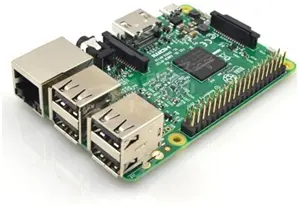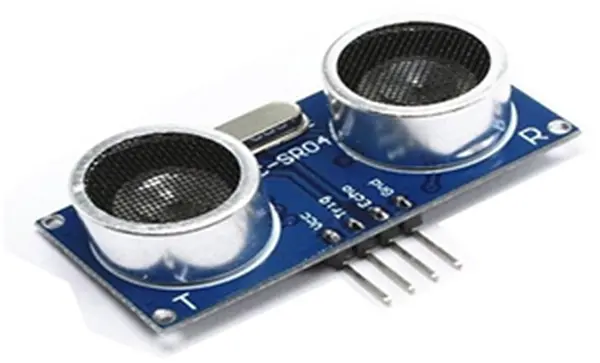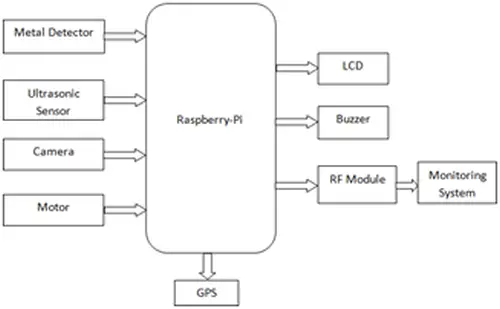Abstract – This paper proposes a solution Introduction to ground arrows. Mine detection is critical Problem in areas where the mines are vulnerable. The instrument shown in Figs This paper uses a robotic vehicle equipped with various components Various components such as metal detector and camera modules, ultrasonic sensors, etc. for automatic detection Earth's arrows. This data or signal a Great distances using GPS to remote sensing system. This surveillance system will be implemented there Accurate ground arrow identification.
Keywords: Gun identification, raspberry pie, metal detectors, robotic cars, ultrasonic sensors, GPS
1. Introduction
Land mines are an explosive device, whose primary intention is to target or a vehicle. Often, the bomb is caused by something specific The amount of explosives placed on a channel and the fusion mechanism of the casing The main blast. a buried underground, while others embedded in lower levels. They can do that Activated by authenticity including devices pressure, tripwire, electrical command, or magnetic influence. Even some modern khans can start using other types of electronic sensors. Land mines are generally divided into two categories groups: anti-vehicle and anti-personnel. Counter- Vehicle or anti-tank mines are pressure activated and. They are designed to do so for the person's position They are not created. Most are military vehicles targeting such mines. There are anti-personnel mines primarily intended for delivery to infantry A specific location. They can obviously do their job Pressure from above or with the help of a tripwire, or by someone close in the default distance.
Ground mines are dangerous and can cause problems such as the removal of a lot of time, equipment, transportation and lack of skilled manpower. Failure to detonate ground mines can cause friendly injury Written by Balani. Various landmine detection methods have been developed It was designed to better detect bombings. a Ground Penetrating Radar technology (GPR) is developed, . Nuclear Quaternary Reaction (NQR), . electrical induction methods, infrared and Hyperspectral techniques. All these methods. Mistakes such as failure to investigate deeply buried mines; Slow detection speed, high false alarm rates and so on. Landmines can be detected by a Number of different sensors and robot technology. Sensors in the system are identified metallic particles; The image is immediately captured
send that field to central control and Processing unit location. There is a picture then solved with an image processing technique
to determine if there are any mines nearby. Various methods like Support vector methods, . It can do sensor fusion, automatic target detection, and more was. When scanning in a given plot Upon completion, the detector returns to its original position.
So robotics and image processing Using strategies can save time, money, Human resources and citizenship.
2. COMPONENTS FOR LANDMINE DETECTION SYSTEM
2.1 Raspberry PI

This paper proposes a landmine detection system using a Raspberry Pi, a single-board computer, as its core. Let's delve into the components, functionalities, and potential of this system.
3. Core Component: The Raspberry Pi
The project hinges on the Raspberry Pi 3 Model B, a credit-card sized computer. This versatile device boasts a quad-core processor, ample memory (1GB LPDDR2), and various connectivity options like Wi-Fi, Bluetooth, and USB ports. Notably, it can handle high-definition video playback, making it suitable for image processing tasks crucial for landmine detection.
- Metal Detector Circuit: This circuit forms the heart of landmine detection. It emits an alternating current through a coil, generating a magnetic field. Any nearby metal object disrupts this field, triggering a signal that alerts the system.
- Ultrasonic Sensor: This sensor acts as the robot's eyes, emitting high-frequency sound waves and measuring their reflection time to determine the distance to obstacles. This helps the robot navigate safely and avoid collisions.
5. System Design and Operation
The Raspberry Pi serves as the central hub, receiving signals from the metal detector and ultrasonic sensor. Here's a breakdown of the envisioned operation:
- Deployment: The robot, equipped with the Raspberry Pi, metal detector, ultrasonic sensor, and a camera, is deployed on the suspected landmine field.
- Automated Search: The robot autonomously navigates the field, programmed to move in a specific pattern.
- Metal Detection: The metal detector continuously scans for metallic objects, potentially indicating landmines.
- Data Transmission: Upon metal detection, the Raspberry Pi transmits the GPS location and a captured image of the area to a monitoring system.
- Image Processing and Analysis: At the monitoring system, image processing techniques analyze the captured image to confirm the presence of a landmine.
- Marking the Location: If a landmine is confirmed, its GPS location is marked on a virtual plot, creating a map of detected landmines.
- Safe Completion: After completing the search pattern, the robot returns to its starting point.
6. Desired Outcome: Enhanced Detection and Safety
The project aims to achieve efficient and safe landmine detection through automation. Here's how it aspires to improve upon existing methods:
- Reduced Risk: By replacing human operators with a robot, the system minimizes the risk of casualties often associated with manual landmine detection.
- Improved Efficiency: The robot can systematically cover large areas in a shorter time compared to manual methods.
- Data-Driven Detection: The combination of metal detection, image processing, and GPS provides a more comprehensive approach for landmine identification and location marking.
- User-Friendly Monitoring: The monitoring system visually displays the detected landmines on a map, simplifying the process for operators and reducing the risk of human error.
7. Conclusion: A Promising Step Towards Safer Demining
While various landmine detectors exist, many rely on human operation, which can be prone to error and endanger lives. This Raspberry Pi-based system offers a compelling alternative. Its automation, data-driven approach, and focus on operator safety make it a potentially valuable tool in landmine detection and demining efforts.
Additional Considerations:
- Sensor Range and Sensitivity: The effectiveness of the system hinges on the metal detector's range and sensitivity to ensure it can detect landmines at a safe distance.
- Image Processing Algorithm Development: Robust image processing algorithms are crucial for accurately identifying landmines in captured images.
- Durability and Environmental Factors: The robot's design needs to be rugged and weatherproof to withstand harsh outdoor conditions.
- Cost-Effectiveness: While the Raspberry Pi offers an affordable platform, the overall system cost needs to be balanced against its benefits for widespread adoption.
This project presents a promising solution in the fight against landmines. Further research and development efforts can refine the technology to enhance its effectiveness and contribute significantly to safer demining initiatives.
Follow this link for complete project: Raspberry- Pi Controlled Landmine Detecting Robot




